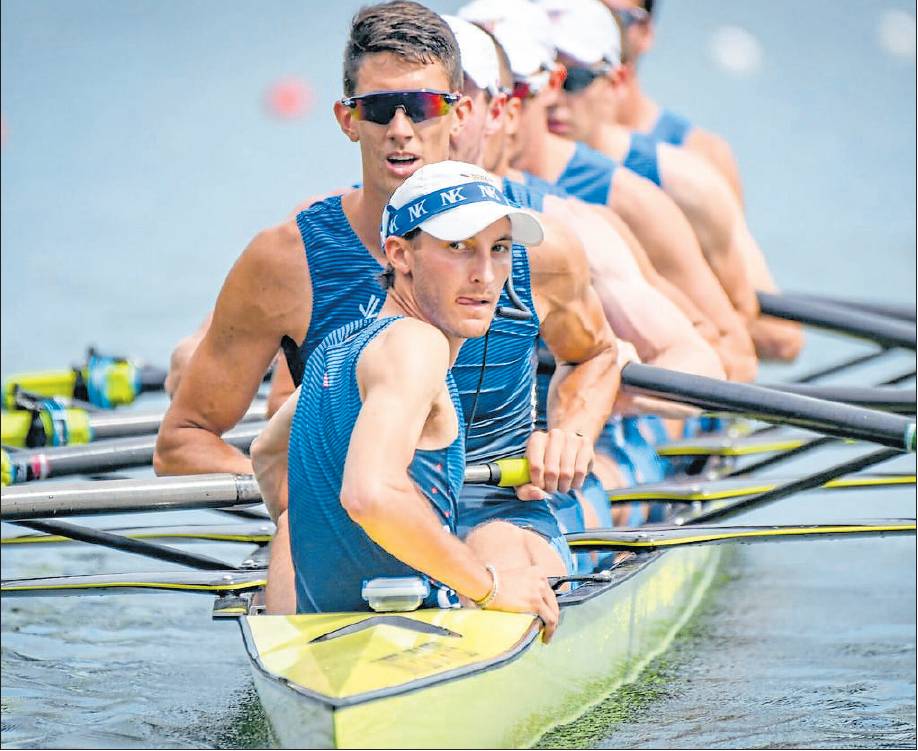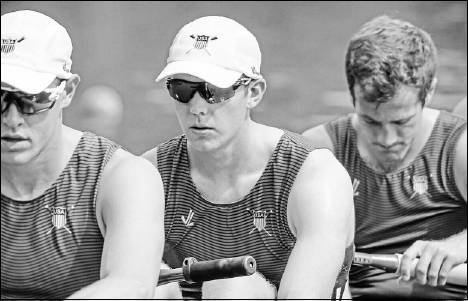TOUGH ROW TO HOE
Locals’ Olympic dreams put on hold, maybe even sunk
BOB FORD @bobfordsports
As the sun rises over the Park Street Bridge between Alameda Island and Oakland, a few blocks from USRowing’s training center just east of San Francisco Bay, a driver can look down at the shipping channel known as the Oakland Estuary and know exactly what kind of day it would be in a racing shell.
In the last few weeks, the water has been flat and sparkling, calling to the rowers at the center training for the men’s Olympic sweep events — the pair, the four, and the eight.
Of course, the water has also remained empty of rowing boats.
“Every morning, I come over the bridge and I look out and I see that it’s pristine there, and I say, ‘Why can’t we go out and row?’ ” said Patrick Eble, from Fort Washington, who rowed for La Salle College High School in Wyndmoor and Princeton University before joining the U.S. senior national team in 2017.
Eble, 25, knows the answer to the question, as do the other 30 or so rowers who were hoping to earn one of the coveted seats in the boats headed for the 2020 Olympics. That hope was put on hold while the athletes observed the Bay Area’s shelter-in-place restrictions, then it was finally dashed last week by the postponement of the Tokyo Games due to the coronavirus pandemic.
“It’s frustrating. There’s a lot of stuff up in the air now,” Eble said. “There’s more questions, and no answers.”
Eble is one of three Philadelphiaarea athletes who have been in the senior pool since 2017. They competed at three world championship regattas, but this year was their chance to make an Olympic team. All were considered likely to be placed by head coach Mike Teti, the Upper Darby native and longtime national coach, in either the four or the eight for Tokyo.
“We’re pretty used to uncertainty under normal circumstances,” said Nick Mead, a 25-year-old from Strafford, Chester County, whose rowing career began at Episcopal Academy and continued at Princeton. “You can train for years, and at the end of four years, you might not make the team and there’s nothing you can do about it. COVID-19 added another level of uncertainty, but we’re used to taking things one day at a time.”
“ We all have worked so hard with 2020 as the goal, however we want to do our part in helping the global community overcome the current situation.
Julian Venonsky, Olympic hopeful from Malvern
The days add up, and now the Olympic calendar has been expanded to include another full year of days. The rowers in the national team program, who have already put their professional and personal lives on hold to pursue the Olympics, must each decide if the additional delay makes sense.
“We all have worked so hard with 2020 as the goal; however, we want to do our part in helping the global community overcome the current situation,” said Julian Venonsky, 26, who is from Malvern and rowed for Malvern Prep before transitioning to coxswain at the University of California, Berkeley. “We will have to wait another year, but that means another year of training, improvement, and opportunities to get faster for 2021.”
The three Philadelphia-area guys represent the main components of an eight-man racing shell: Mead is one of the coal shovelers who typically dominate the more stable engine room of the boat from the third seat to the sixth seat; Eble is a technically elite rower best suited for the tippier ends of the boat, in the bow and second seat, or in the seventh and stroke seat in the stern; and Venonsky is the captain of the boat as its coxswain, steering it with a rudder, and verbally executing the race plan for the coach on shore.
They were first together in the eight that went to the world championships in 2017, manning three of the four places in the sternmost of the boat; with Eble at stroke, eyes fixed on Venonsky for the count, and Mead churning away in the sixth seat. That boat took the silver medal, finishing behind only a German team that set the record time (5 minutes, 18.68 seconds) for a standard 2,000-meter course that same year.
It has been a great partnership, and who knows if they will ever share the same boat again?
Mead’s journey to this place began at Episcopal as a winter training method to stay in shape for lacrosse. There was some extensive family history with the sport. His father rowed at Princeton, his mother had been a walk-on to the Penn team, and an older brother was also a successful rower. Within a year, Mead found that he loved the challenge of the sport and made the switch full time.
Venonsky competed in single scull at Malvern Prep for two years, then was in the lightweight double and quad sculls as a junior and senior. The Malvern program didn’t have sweep boats — in which rowers have single oars as opposed to two oars in the scull events — so he only made the transition to coxswain when he entered school at Berkeley.
“I wanted to remain in the sport at the highest level possible,” Venonsky said. “It was a huge learning curve. Being on the other side of the oar is very different, but in my freshman year at Cal I hit the ground running.”
Eble got into rowing when he was cut from the freshman basketball team at La Salle College High and looked for something to do in the winter between football and baseball. The basketball coach was one of those who suggested rowing as an alternative.
“In my head, I remember being, like, ‘Yeah, probably not,’ ” Eble said. “But I tried it out and I was actually pretty good at it. I was generally strong, and I liked the numbers in front of me, and the competition element of it, so I just found my way to the erg [the indoor rowing machine that measures ergonomic work rate], ended up getting fast on the erg, and then gave up baseball in the spring to try this rowing thing. It just exploded from there.”
All three got involved in USRowing’s developmental camps and were in the pool for the U.S. junior national and U-23 teams before making the senior national pool. That, along with successful college careers, led them to the quadrennial ride that was supposed to end this summer at the Tokyo Olympics. Until last week, that was still the case.
“We recognize that the IOC made the correct decision,” Mead said, “but it’s still difficult to realize that we now have many more months of selection and training ahead of us. Right now, I’m still training on the erg and hoping that we can get on the water and row as a team again soon.”
Most of the rowers at the Oakland camp have part-time or fulltime jobs to supplement their modest USRowing living stipends and to prepare for life after rowing. Mead works for an investment group in San Francisco. Venonsky, who majored in the history of art at Cal, works in the online art market. Eble is with a California private equity firm that is opening a New York office. That was supposed to be his next move.
“I’m trying to figure all that stuff out,” Eble said. “It’s a weird situation to be in.”
In what were normal days, Eble was up at 5:15 a.m., over the Park Street Bridge, and at the boathouse in time to warm up for a 6:20 meeting when Teti would announce the morning lineups. Sometimes, the lineups were the same. Sometimes, the coach would swap guys into different seats or different boats, looking for the fastest combinations.
There would be one or two morning sessions on the water, either a steady-state row, or a hard racing session, and then off the water by 8:30 a.m. Eble would clean up, take the light rail into San Francisco, work until about 4:30 p.m., then head back for an erg workout or a second rowing session if daylight allowed.
“My days were packed, but I loved it all,” Eble said.
Now there is just the socially distanced training on an isolated erg and the trip over the bridge in the morning with the smooth water below and the empty boathouse dock. Venonsky will remain in training for the Olympic selection, whenever it arrives, as will Mead. But Eble, who has the job waiting and is getting married next June, isn’t as sure.
“I have been planning my life to not be rowing after July 2020,” he said. “If it’s fully pushed back a year, my inclination is to stop training. If they just bought some extra time and it was September or October, I’d probably stick around and kind of move some things around. That’s a little bit of a dependent answer, but if it’s pushed back a year, then I’m probably not training. It’s tough to grapple with.”
The water is right there, and it is beautiful and calm, but also unreachable. There are good reasons for that, and more important things than dipping the hull of a boat into the unrippled surface of the estuary. For many of them, there will probably be another chance. Not for all, however. The current carried them this far, so close to the finish line, but not far enough. bford@inquirer.com bobfordsports



